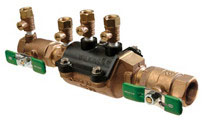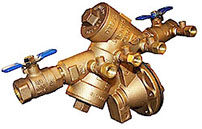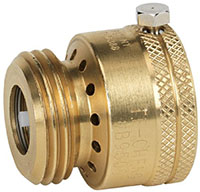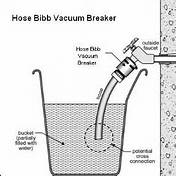What is a Cross Connection?
A cross connection is any physical connection between a public or consumer’s water system and any source of non-potable liquid, solid, or gas that could contaminate the potable water supply by backflow.
What Is Backflow?
Backflow is the undesirable reversal of the flow of water from its intended direction in a pipeline or plumbing system. It can result from a loss of pressure in the public water system (for example, due to a large leak), which can in turn draw non-potable water from the customer’s property (fire sprinkler systems, irrigation systems, hot tubs, etc.) into the public water system at unprotected cross connections. Prevention of backflow at cross connections (“cross connection control”) is critical to protecting public health.
What Am I Responsible For?

Irrigation/Fire system without chemicals backflow protection
Per WAC# 246-290-490, property and business owners are required to install and maintain backflow prevention assemblies where they are needed. WWSC customers are also responsible for having their backflow assemblies tested annually by a State Certified Tester.
About Backflow Assemblies
A backflow assembly is a mechanical device required by law to protect public health and is installed on a customer’s property to prevent contamination from entering the potable water supply. Common types of assemblies include:

Auxiliary source of supply/radiant floor heating system connected to water supply backflow protection
- Double Check Valve Assembly-DCVA
- Reduced Pressure Backflow Assembly-RPBA
- Pressure Vacuum Breaker-PVB
Where Is a Backflow Assembly Required?
A backflow assembly is required wherever there is a possibility of a cross connection between the public water system and a non-potable water source. Examples include, but are not limited to, irrigation systems, boilers, hot tubs, and other water-using equipment.
Find a Certified Tester
Visit Washington Certification Services for a list of certified Backflow Assembly Testers (BAT) by county, or see our list of testers and installers.
What Will Happen If I Do Not Have My Backflow Assembly Tested?
The law requires that your backflow assembly be tested annually to ensure that it is working properly and to protect public health. Failure to test the assembly increases the risk that it will fail to protect the water supply. WWSC will mail reminder notifications about backflow assembly testing requirements to you annually. However, please be aware that it is the customer’s responsibility to ensure that the assemblies are tested on time. If an assembly is not tested, WWSC will take action, starting with assessing fees and leading to termination of water service.
WWSC will make every effort to work with the customer to avoid these actions from being taken, but WWSC must imperatively ensure that the drinking water system is protected.
A Reminder About Outdoor Faucets
Everyday things you do when using an outdoor faucet can put you and your family at risk. If an outdoor faucet is in contact (directly or via a hose) with dirty water and there is an unexpected change in pressure, that water can be sucked back into your home’s drinking water pipes.
Tips To Prevent Outdoor Faucet Backflow
The easiest and best way to protect your family is to install vacuum breakers on all outdoor faucets. Vacuum breakers completely prevent backflow through outdoor faucets and are available at all major home improvement stores for around $5 each. All Homes built in 1996 and after per plumbing code, already have vacuum breakers on outdoor faucets.
If you choose not to install vacuum breakers make sure you:
- Never leave a hose submerged in a bucket of water — submerging briefly can make a big difference
- Hold hoses above the water line when filling pools, hot tubs, etc.
- Do not use fertilizer sprayers
 |
 |
| Hose Bib Vacuum Breaker | |
Information for Testers
See the Backflow Assembly Test Guidelines page for our standardized testing report form, requirements, and instructions on how to submit test reports.


